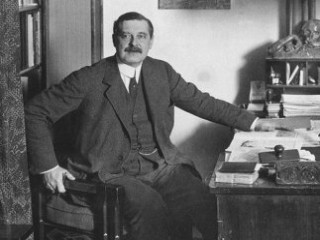
Peter Behrens biography
Date of birth : 1868-04-14
Date of death : 1940-02-27
Birthplace : Hamburg, Germany
Nationality : German
Category : Arhitecture and Engineering
Last modified : 2012-01-19
Credited as : architect, designer, was important for the modernist movement
1 votes so far
Behrens attended the Christianeum Hamburg from September 1877 until Easter 1882. He studied painting in his native Hamburg, as well as in Düsseldorf and Karlsruhe, from 1886 to 1889. In 1890, he married Lilly Kramer and moved to Munich. At first, he worked as a painter, illustrator and book-binder in a sort of artisanal way. He frequented the bohemian circles and was interested in subjects related to the reform of life-styles. In 1899 Behrens accepted the invitation of the Grand-duke Ernst-Ludwig of Hesse to be the second member of his recently-inaugurated Darmstadt Artists' Colony, where Behrens built his own house and fully conceived everything inside the house (furniture, towels, paintings, pottery, etc.) The building of this house is considered to be the turning point in his life, when he left the artistic circles of Munich and moved away from the Jugendstil towards a sober and austere style of design.
He was one of the leaders of architectural reform at the turn of the century and was a major designer of factories and office buildings in brick, steel and glass. In 1903, Behrens was named director of the Kunstgewerberschule in Düsseldorf, where he implemented successful reforms. In 1907, Behrens and ten other people (Hermann Muthesius, Theodor Fischer, Josef Hoffmann, Joseph Maria Olbrich, Bruno Paul, Richard Riemerschmid, Fritz Schumacher, among others), plus twelve companies, gathered to create the German Werkbund. As an organization, it was clearly indebted to the principles and priorities of the Arts and Crafts movement, but with a decidedly modern twist. Members of the Werkbund were focused on improving the overall level of taste in Germany by improving the design of everyday objects and products. This very practical aspect made it an extremely influential organization among industrialists, public policy experts, designers, investors, critics and academics. Behrens' work for AEG was the first large-scale demonstration of the viability and vitality of the Werkbund's initiatives and objectives.
In 1907, AEG (Allgemeine Elektrizitäts-Gesellschaft) retained Behrens as artistic consultant. He designed the entire corporate identity (logotype, product design, publicity, etc.) and for that he is considered the first industrial designer in history. Peter Behrens was never an employee for AEG, but worked in the capacity of artistic consultant. In 1910, Behrens designed the AEG Turbine Factory. From 1907 to 1912, he had students and assistants, and among them were Ludwig Mies van der Rohe, Le Corbusier, Adolf Meyer, Jean Kramer and Walter Gropius (later to become the first director of the Bauhaus.) In 1922, he accepted an invitation to teach at the Akademie der Bildenden Künste in Vienna.
Peter Behrens remained head of the Department of Architecture at the Prussian Academy of Fine Arts in Berlin. In 1926, Behrens was commissioned by the Englishman Wenman Joseph Bassett-Lowke to design him a family home in Northampton, UK. The house, named 'New Ways' is often regarded as the first modernist house in Britain. In 1936 Behrens was called from Vienna to conduct a Master class in architecture, in succession to Hans Poelzig, at the Akademie der Kunste in Berlin, reportedly with the specific approval of Hitler. Behrens became associated with Hitler's urbanistic dreams for Berlin with the commission for the new head quarters of the AEG on Albert Speer's famous planned north-south axis.
Speer reported that his selection of Behrens for this commission was rejected by the powerful Alfred Rosenberg, but that his decision was supported by Hitler who admired Behrens's Saint Petersburg Embassy. Behrens and the academy helped his cause by reporting to the Ministry that Behrens had early joined the then illegal Nazi party in Austria on May Day of 1934. The vast AEG building with its marshalled fenestrations and detailing, like the project of which it was a part, mercifully was not built. War ensued instead. Behrens, seeking refuge from the cold of his country estate, died in Berlin's Hotel Bristol on 27 February 1940.
Peter Behrens was a pioneer in everything he did in the first half of the 20th century and his ideas were spread around the world by his students, especially by Walter Gropius, Mies van der Rohe and Le Corbusier. The creation of the concept of corporate identity (see also: Corporate design) had a direct influence in other post WWII companies such as Braun (company) or McDonald's. Peter Behrens is also responsible for German Modernism. He is seen as an important aspect in the transition from Jugendstil, which is similar to Art Nouveau to industrial Classicism, which is incorporating ancient Greek or Roman style to a structure. Example of industrial Classicism is the AEG Turbine Factory.
















